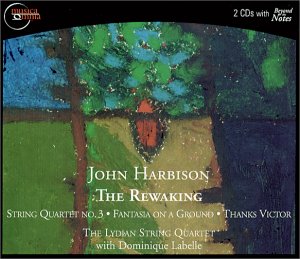John Harbison is one of America’s most prominent and
popular contemporary composers. Among his principal works are three
string quartets, three symphonies, the cantata The Flight Into Egypt,
which earned him a Pulitzer Prize in 1987, and three operas including
The Great Gatsby, commissioned by the Metropolitan Opera and premiered
to great acclaim in December 1999.
The Rewaking is a setting of four late poems by William
Carlos Williams. It was commissioned by the Pittsburgh Music Society
for the soprano Benita Valente and the Juilliard String Quartet and
premiered by them in 1991. The composer is at pains to point out that
the work is neither ‘a quartet with vocal apotheosis, like Schoenberg’s
Second, nor a song cycle with string accompaniment’. He claims it to
be, instead,’ a quintet in which the theme of "rewaking" from
a winter of the spirit is carried forward equally by all five performers’.
Well, the composer knows best, as they say, but any work which features
a soprano soloist and string quartet is bound to invite certain comparisons
with the Schoenberg. Indeed, if one remembers the Viennese master’s
handling of his formal material, and the way the singer magically floats
in with Stefan Georg’s prophetic words, ‘I feel the air blowing from
another planet', we do not seem to be too far from Harbison’s sound
world. However, repeated hearings confirm the composer’s intention of
interplay between five equal partners to be entirely valid. The piece
opens with what is effectively a prelude that, in time honoured tradition,
sets out the main melodic material of virtually the rest of the work.
Given the title of this movement, 'The Woodthrush’, it is no surprise
to hear in the soprano’s first entry a melismatic, decorative theme
(wordless at first) that portrays its subject in vocal terms, with sinewy
string counterpoint and continuous overlapping of instruments further
enhancing the imitative effect. There is a magical moment at 4’33’’
(significant?) when the accompaniment stops and the soprano sings wistfully,
'...he looks at me silent – without moving…'
The second movement, 'To a Woodpecker’ is again imitative
of its subject, with repetitious, insistent patterns of sound that are
as obsessive as the bird (Harbison talks about having literally transcribed
the rhythms on his Wisconsin farm). The singer has angular thematic
lines, often in unison with the strings, but the recurring patterns
give it a short ‘scherzo’ – like feel. In the third movement, ‘The Lady
Speaks', tempestuous, dissonant chords portray the buffeting of a storm
and 'tragic winter thoughts', out of which the lady does indeed speak,
but this time of endurance and persistence. The finale is ‘The Rewaking',
in which the symbolism of the poetry – the new found hope after a winter
of the spirit – is amply portrayed in the most ‘American’ sounding music
in the piece. The big, openly Romantic harmonies underpin lines such
as " ..and so by your love the very sun itself is revived…"
and could easily tip over into sentimentality; it is to the composer’s
credit that he never allows this to happen. Indeed the very ending,
with its strange glissandi and use of high harmonics, has a rather icy,
uncomfortable feel that is anything but reassuring. The performances
are exemplary, with the quintet blending beautifully and holding rock-steady
intonation.
The other major piece on this disc is the 3rd
String Quartet, a single 22 minute movement which, in its long unbroken
sweep, effectively encompasses many moods. The composer shows us (on
disc 2) how all the material is based on a hymn-like theme stated at
the outset; this tune becomes a sort of ‘cantus firmus’ (literally ‘fixed
melody’) that forms the backbone of the work, evoking as it does the
tradition of American hymn singing and the much older tradition of plainsong.
The overall impression is of hymnodic chant, with much homophonic or
near-unison writing consciously avoiding the typical contrapuntal interplay
of the four string quartet instruments. The contrast is provided by
two interludes which break up the continuous flow and provide a more
melodic and relaxed foil for the main material. The performance is once
again ideal, with the dedicatees providing the requisite warmth, tonal
homogeneity and rhythmic bite needed to do the piece justice.
The two short fill-up pieces are no less rewarding.
Fantasia on a Ground is one of a series of pieces for young performers,
most of them written for the Music School at Rivers in Weston, Massachusetts.
The composer admirably states that this is an ongoing part of his creative
process, and indeed keeps him in touch with the ‘fundamentals’ of his
craft, something not always seen as a priority by ‘advanced’ composers.
The delightful potpourri that makes up the last piece,
'Thanks Victor’ is essentially a tribute to the prolific film composer
and arranger Victor Young. It consists of arrangements and improvisations
on four of Young’s songs (including the famous 'When I Fall in Love')
strung together into a short suite. Harbison calls it ‘an imaginary
recreation of what a quartet by Victor Young might have sounded like’.
The overall standard of presentation of this set is
admirable; as mentioned above, the performances are all of a very high
standard and the booklet notes instructive. It is a pity the texts of
the poems were not included, though it has to be admitted that the singer’s
diction (and excellent recording) makes up for this. What is especially
valuable is the disc of in-depth interviews with composer; this is something
that ought to be done more often regarding new music (I remember Hyperion
doing something similar with Robert Simpson’s 9th Symphony,
as did Naxos with Arnold’s 9th – though less successfully). It allows
the listener to be authoritatively guided in unfamiliar repertoire and
gives the ear a ‘way in’ to what can be daunting process.
A stimulating release.
Tony Haywood


